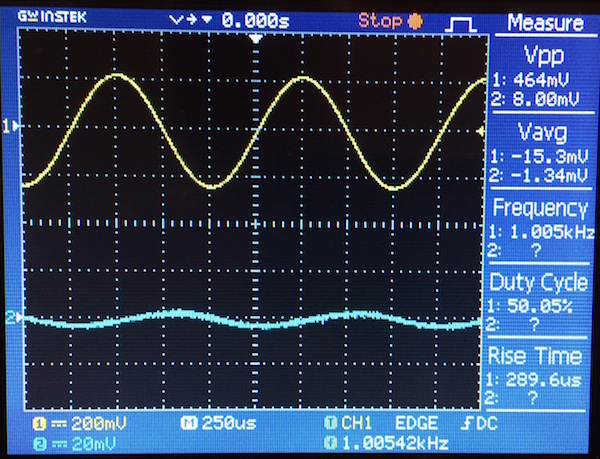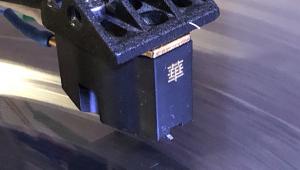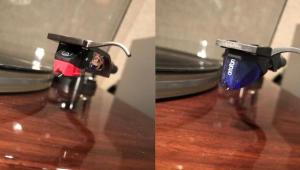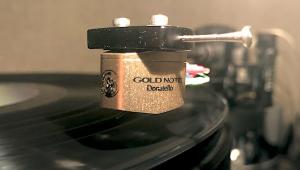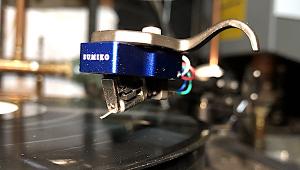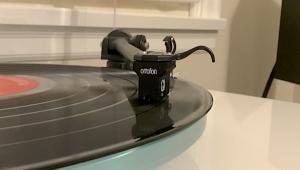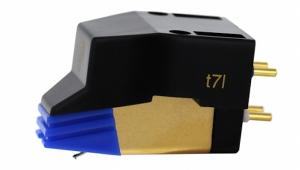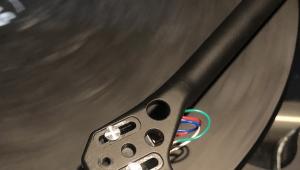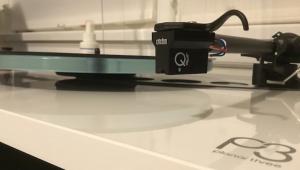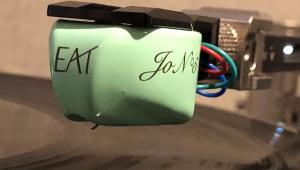Moving magnet designs are also fixed coil. So it's pointless to eschew the useful distinction provided by "moving iron" unless you're fond of marketing BS.
Soundsmith’s new Zephyr MIMC Star Cartridge: Luxury You Can Afford
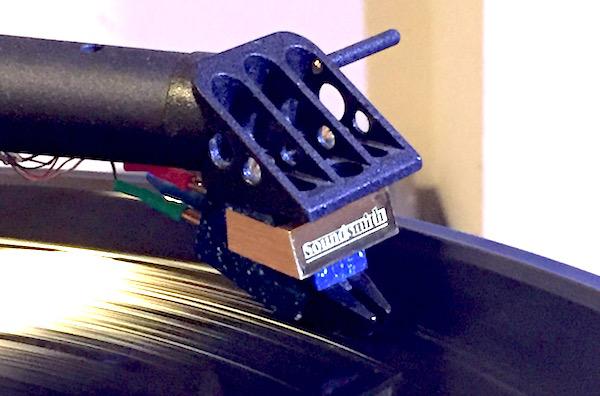
B&O had abandoned its customers when it exited the turntable business, leaving turntable owners with no way to spin vinyl.
Ledermann approached B&O and when the company wasn’t interested in supplying him with the technical plans he asked if he could back-engineer it. Their response was “good luck to that” (or words to that effect).
Ledermann managed to do just that, and soon established a successful worldwide business supplying B&O customers with replacement “plug in” “moving iron” cartridges.
When that market was saturated, Ledermann began building standard mount versions and thus was born another business just as the vinyl resurgence began..
Over the years he’s refined and modified the basic design, which he prefers to call “fixed coil” rather than “moving iron”. There are more models and versions priced from moderate to expensive producing various outputs, than I think is healthy but that’s just my opinion.
The new $1749.95 Zephyr MIMC Star is Soundsmith’s entry point into its high end, low output lineup. Before you consider that not “affordable” consider that if you mess up and snap the cantilever during installation, Soundsmith will rebuild it at this time for $350. Even after you’ve worn out the stylus, the cartridge can be rebuilt for the same amount “at this time”. Most MC cartridge “re-tips” cost approximately half of list price, so do the math: you get “two” Zephyr Stars for around $2100.
Right now Soundsmith is offering another buying incentive: buyers of the first 1500 Zephyr Star cartridges will receive a small golden envelope corresponding to a free gift from Soundsmith ranging from a set of EZ Mount Screws (1420) to an SG-210 Strain Gauge cartridge (4). In between are Hyperion cartridges (6), Sussurros (10) and four other cartridge models (15 each). So you are guaranteed to get something if you buy one of the first 1500 Zephyr Stars.
The Zephyr Star, which weighs 10.27 grams, features a Sapphire cantilever (says “Boron” on the company’s website) laser drilled to accept the Selected Contact Line low mass nude stylus, and borrows much of its internal technology from the $4800 Sussurro cartridge that I reviewed some time ago in Stereophile. The Zephyr Star’s compliance is suitably low at 10µm/mN, its rated channel separation at 1K is rated at greater than 28dB and 25dB between 50Hz and 15kHz.
The name is an acronym for “Moving Iron for Moving Coil preamps). In other words, with its .4mV output, the MIMC should be used with a moving coil phono preamp capable of producing between 58-64dBs of gain.
Recommended tracking force is between 1.8-1.9 grams. So far this sounds like standard MC fare but because of the design, it is particularly sensitive to loading and its loading requirements are different from those of a typical MC cartridge. Soundsmith recommends loading to 470 ohms or more to avoid high frequency roll-off. A Soundsmith spokesperson recommends closer to 1000 ohms, but this is a personal choice. However, once you get below 470ohms you’ll easily hear the top end roll off. You can try 47kOhms too but you’ll probably hear an undamped resonant peak.
So here’s where you have to carefully consider your phono preamp’s capabilities. In MC mode, some don’t extend loading much beyond a few hundred ohms, and if yours has a step-up transformer based input, you’d best determine the effective load before considering a Zephyr since while you can often load down the input, you can’t load up.
The “Fixed Coil” (or “Moving Iron”) Advantage?
Rather than going through Soundsmith’s advocacy here, why not go here and read for yourself the company’s claims for the technology keeping in mind that there are always two sides to every story!
Two claims I will corroborate are those for quiet hum-free operation and especially the one for high dB channel separation. I measured 35.5dB of separation in both directions (L-R and R-L) with the head shell parallel to the record surface, no azimuth adjustment necessary. Now you could say this one was “hand picked” for the review, but that’s also possible for other cartridges I’ve been sent for review, and other than a $9995 Lyra Etna SL that measured 36dB (and not the one I was sent, but rather one I recently set up for a friend), I’ve not measured another cartridge that produced such crosstalk results.
The oscilloscope trace on top in yellow shows the 1kHz test tone modulating the left channel of the test record. Theoretically the blue trace should be flat, which would mean no crosstalk but of course there’s always some. In this case the blue line is about as flat as I’ve seen. Usually there’s more of a visible wave, indicating higher crosstalk.
Zephyr Star Sonics
As the measurements predicted, the Zephyr Star produced as wide a soundstage as I’ve experienced in my room: wide, deep, stable and three-dimensional. Images on the stage were three-dimensional and satisfyingly solid. More impressive was the presentation’s liquidity and complete freedom from mechanical artifacts.
The Zephyr Star smoothly handled the toughest vocal sibilants and overall produced liquidity not compromised by a soft finish.
One of the first records I played was Analog Sparks’ spectacular reissue of A Fiddler on the Roof (79301836821-6/RCA LSO-1093) finally not hobbled by Dynagroove processing. This 1964 Webster Hall recording features a wide, some might say overly L/R staging but the presentation through the Zephyr Star was ultra-stable and well reproduced the reverberant field that holds together the mix despite the occasional separation extremes.
The front to back three-dimensionality projected Zero Mostel well into the room well forward of a line between the speakers, and the effect was to bring the great actor back to life in the ways only the very best cartridges manage.
However vinyl’s dynamic range gets measured, the reality is far wider dynamics than measured as this record proves. You won’t be disappointed by this cartridge’s spatial presentation, I don’t care what cartridge you use or how much you’ve spent.
Its dynamic presentation is also bold and unrestrained, unless you are used to far more costly cartridges where you can get greater microdynamic subtlety (small dynamic shifts) and better “image carving” and solidity with blacker background black (you do get what you pay for when you spend $5000, $8000 and more for a phono cartridge) but with the Zephyr Star, I think you will get more for your $1749.95 than you were expecting to get.
Installed in a Kuzma 4 Point, the Zephyr Star proved to be a super tracker and with its low mass Contact Line stylus an equally good tracer, able to get into the smallest groove “nooks and crannies”. I played ORG’s double 45 reissue of Ella Fitzgerald Sings the Rodgers and Hart Song Book (Verve MG VS-64022/ORG 055) and found the liquidity, and freedom from mechanical and/or sibilant artifacts made for very smooth and enjoyable listening but with transient details mostly intact. The Zephyr Star is a “smoothie” without being a “softy”.
In term of frequency response, I found the Zephyr to be without “lumps” and obvious “bumps”. With the phono preamp correctly configured, the subjective response is neutral with perhaps a bit of an midband overemphasis that produces a billowy, airy fullness that well complements many speakers. The Zephyr’s bottom end is robust and well-controlled, while the top end is airy, extended and seemingly limitless—all without producing edge, spotlighting on top or bloat on bottom. An impressive tonal performance!
Conclusion
At the under $2000 price point, the new low output Soundsmith Zephyr MIMIC Star is an overachiever that gives you a glimpse of the best in terms of non-mechanical, artifact-free performance, for a small percentage of the state of the art asking price. With measured 36dB chancel separation the Zephyr Star’s spatial performance is up there with the best at any price, as is its smooth, reasonably fast and non-mechanical overall demeanor.
If you crave more tightly drawn, solid and compacted images, sharper, faster, better focused transients and blacker backgrounds they can be found, but at a far higher price-point. Soundsmith’s new Zephyr Star is a star.
- Log in or register to post comments


Let me get this straight, Michael. You agree "both moving iron and moving magnet cartridges have fixed coils" (I'm quoting YOUR words) and maintain that a distinction is necessary because they are "VERY different"? Maybe you should try thinking before rushing to insult your readers.

Well said Michael, and so do bulls, and thats no B.S!!

I don't need a discussion on the differences between MM & MI designs and this doesn't seem like a suitable forum for that. The real question is why does Soundsmith prefer to call its cartridge fixed coil rather than moving iron. Is it because they want to be more precise in their description? Obviously not. As a category, fixed coil includes both MM & MI. As I originally said, Soundsmith chooses to eschew the more specific term. It's not incorrect to call it a fixed coil cartridge, but why waste someone's time telling them it's a fixed coil cartridge, when stating it's a moving iron cartridge already tells them that and more. I concluded it was marketing BS. Apparently you disagree with my conclusion, but have completely avoided giving a reason why. You didn't give an answer to address the real issue, instead you gave some detail about the differences between MM & MI. When I was in school, that sort of answer technique also received the label of BS. If you bother to reply, just tell me why you think it is better to call it FC rather than MI. Or better yet, ask Soundsmith because, honestly, it's unreasonable for me to expect you to know what they were thinking.

Michael explicitly explained to you why your statement is insulting and how he corrected you, and why.
He is exactly right, and by your lack to clarify your statement you came off convicting and rude (and more importantly, utterly ignorant of the two concepts of moving iron and moving magnet). It can be called a fixed coil, if you researched how that cartridge is assembled. I think I'll let the cartridge's designer (and technically the inventor of this version of technology) have his right to call it what he feels.
If Michael wants a discussion of the two designs, it's his site, and you do need one.
You were simply splitting hairs in a petty accusation.

Michael explicitly explained to you why your statement is insulting, and how he corrected you and why.
He is exactly right, and by your lack to clarify your statement you came off convicting and rude (and more importantly, ignorant of the two concepts of moving iron and moving magnet). Stereophile reviews covered the differences in past issues and online.
It can be called a fixed coil if you researched how that cartridge is assembled. I think I'll let the cartridge's designer (and technically the inventor of this version of technology) have his right to call it what he feels. If he feels the term 'moving iron' is inadequate, that's valid.
Note the term in this product is more of a comparison between moving coil and moving iron (or fixed coil), than of MM and MI. After all, this is a Low output fixed-iron cartridge, and a different approach than the higher output cartridges that Soundsmith has created in past years.
If Michael wants a discussion of the two designs, it's his right, and where else would this be appropriate? (Really.) It's his site and you do need a discussion, as does some of the trolling public.
You were simply splitting hairs in a silly, petty accusation. That's BS.

Have you heard the Zephyr Mk II in comparison? I was hesitant with the loading options of my JC3+ to get the Zephyr MIMC so I bought a Zephyr II recently. I'm overall very pleased with the sound as it's breaking in. I am curious what tradeoffs are there in terms of sound.

I would be glad to take part in this discussion on a one time basis. I am leaving for Munich for the high end show tomorrow, and don’t have much time. I also tend to stay off forums as there are always those who feel the need to attack, and I reward them by going away.
Both of you are correct, but it requires a detailed explanation. Having repaired tens of thousands of MC, MM and MI designs over the past 40+ years, I have more than a unique perspective. Some of this is from speaking with so many customers over than period as well, and the other is from teaching audio over that period.
The other issue is the large number of young folks entering the analog market. They are very interested in being informed, and the history of my company has been, and will continue to be, to inform.
Although the term “fixed coil” covers both MI and MM, it also conveys a very important point that makes the less informed (not you) question the technology. We think that is good. They are for the most part, well aware of MC, as it clearly dominates the market. When we use the term “Moving Iron” – the almost ubiquitous response is - “That sounds heavy”…..even from the well informed. It does not convey the fact that our designs’ moving mass is 5 to 8 times LOWER than MC.
Using the alternate term “fixed Coil” draws these newbies into the conversation. They want to understand HOW one can build a fixed coil (as they thing the coil HAS to move), as they often only know Moving Coil. They want to understand what the differences ARE between MC, MM and MI. From that standpoint, the use of FC is a marketing term that works. But it is important to understand that having been in audio design for over 40 years, I have seen more than my share of what you call marketing BS. If you review my history, you will see that I have always been involved in novel, forward designs, and spoke about them openly. I have NOT used marketing terms to represent products in the effort just to give the appearance of a novel or forward engineering advance – I have actually done them.
But the other major reason for moving to Fixed Coil is because it sends a very important message. Moving Coil designs are subject to many failure mechanisms that fixed coils are not – one being work hardening of the lead out “moving” wires. Anyone who has bent a coat hanger back and forth understands work hardening. Fixed Coil says exactly what it is – a critical part of the system that does NOT move, and is therefore far more reliable in at least that one critical sense alone. Michael was very generous in creating a link in his review to my essay on our Fixed Coil designs, complete with photos and technical explanation of why we do what we do, and why others do not. He also mentioned our rebuild policy – multiple rebuilds for 20% or LESS, on all FC products, and not just to the original owner. My company is built on value – long term value, and standing behind customer who by our designs. That is not BS either.
The new high output Zephyr MKIII continues its tradition of being a bit warmer, somewhat more sultry and lush sounding cartridge compared to others, including the Zephyr MIMC Star. Some need or prefer that kind of presentation. The Zephyr MIMC Star features a novel cantilever/diamond structure, but more importantly, derives its internals from the advances we made in our Sussurro MKII. Some trickle down technology…….
I appreciate your opening up this discussion – I hope this cools things off – the world is hot enough and those who stay cool are in great danger of contamination.
Thank you for your post.
Peter Ledermann/President

Thank you very much Peter for taking time to go into the detail you have in explaining the technology and why you have described your cartridges the way that you have. It was very informative.

Agreed, no need to get confrontational over a cartridge!

Until now.
I think you make a great point about being more open to newbies. Their normally cynical views can be informed and brought to a place of acceptance, so that this great hobby can be continued for the very future of it. I feel my own attitude needs to change just a tinge...
Before I read the comments (while contemplating MF's review), I thought what are we going to do when you aren't around? With AJ Conti's passing recently, and less and less brick and mortar audio stores, I sincerely worry about the future of hifi. (AND the rest of you alte kakers... I hope you all live long lives!)
I am still in love with my Carmen, and thank you for keeping rebuilding costs down for us less well-heeled consumers. I really love the new site as well! Just fantastic design, art and content.

Until now.
I think you make a great point about being more open to newbies. Their normally cynical views can be informed and brought to a place of acceptance, so that this great hobby can be continued for the very future of it. I feel my own attitude needs to change just a tinge...
Before I read the comments (while contemplating MF's review), I thought what are we going to do when you aren't around? With AJ Conti's passing recently, and less and less brick and mortar audio stores, I sincerely worry about the future of hifi. (AND the rest of you alte kakers... I hope you all live long lives!)
I am still in love with my Carmen, and thank you for keeping rebuilding costs down for us less well-heeled consumers. I really love the new site as well! Just fantastic design, art and content.

I have been happy with my MusicMaker mkIII MI/Fixed Coil cartridge for years. I've heard really good MCs, like Allaerts, Lyra etc, but always come back to MusicMaker. Can't Explain why...

I don't understand some peoples ranting posts......Ending any post with "BS" is a rant/flame post.
My next cart will likely be a Soundsmith, it's gonna be awhile though as I just took delivery of a Lyra 6 weeks ago. Working with a seller of both the deal came in better on the Lyra.
Gorgeous cartridge....


Six months ago I bought a new MIMC from one of the big web dealers we all know and love and I have not mounted mine yet as I have some other cartridges that are mounted and dialed in. I am looking at my SS box, still sealed, and mine does not say "Star" anywhere. Just MIMC Low Compliance Stereo Low Output. What is the difference between the Star and the regular MIMC? I just rechecked your website (speaking to Peter here) and I see no reference to the "Star".

I want to add that, as others have noted, Peter Ledermann is, IMHO, a national treasure. When he stops innovating designs and stops repairing cartridges, some of us are going to feel up a creek without a paddle. Let's not forget that virtually no one else in the US does what he does and that some of the top international cartridge makers like Benz and Ortofon have had difficulty with production, distribution, and supply.

Just read you review (albeit a few months later than written). Thank you for sharing your experiences with the loading challenges with this cart. I'm curious what pre-amp you used for this review or should i say what pre-amps you have had success with meeting the loading requirements for this cart.
Thanks, jake

Open a music studio and record your voice.

Hi Michael, i had an EMT JSD6, Lyra Kleos/Skala/Titan i/DV XX2MK2.
No one of this cartridges was so good as my VdH Frog in a SME-V.
I had a few bad build Frogs, but this one is great. No installed the Soundsmith MIMC on an Origin Live Conqueror an i love this cartridge and agree to 100% your review. It is the balance of the frequency balance and clarity of the transients. I run it with 1k ohm on a Pass XP25.
Here you can see the results with Adjust+


I think Soundsmith is a great option for us, because the favourable retipping service. In past VdH was the company for me, but the build quality is too bad.

Recently got the Zephyr, absolutely amazing. Soundstage is like 20' wide and 10' deep.... and the imaging sits in this huge soundstage. I have a front row seat at the concert. Over the top cartridge...
